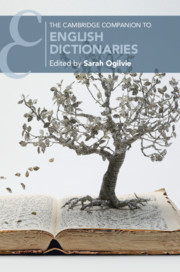Book contents
- The Cambridge Companion to English Dictionaries
- The Cambridge Companion to English Dictionaries
- Copyright page
- Dedication
- Contents
- Illustrations
- Tables
- Notes on Contributors
- Acknowledgements
- Chronology
- Chapter 1 Introduction
- Part I Issues in English Lexicography
- Part II English Dictionaries Throughout the Centuries
- Chapter 8 A Dictionary Ecosystem: Four Centuries of English Lexicography
- Seventeenth-Century English Dictionaries: Hard Words
- Eighteenth-Century English Dictionaries: Prescriptivism and Completeness
- Chapter 11 Recording the Most Proper and Significant Words
- Chapter 12 Samuel Johnson and the ‘First English Dictionary’
- Nineteenth-Century English Dictionaries: Descriptivism
- Twentieth and Twenty-First-Century Dictionaries
- Part III Dictionaries of English and Related Varieties
- Guide to Further Reading
- Index
- Cambridge Companions to Literature
Chapter 11 - Recording the Most Proper and Significant Words
from Eighteenth-Century English Dictionaries: Prescriptivism and Completeness
Published online by Cambridge University Press: 18 September 2020
- The Cambridge Companion to English Dictionaries
- The Cambridge Companion to English Dictionaries
- Copyright page
- Dedication
- Contents
- Illustrations
- Tables
- Notes on Contributors
- Acknowledgements
- Chronology
- Chapter 1 Introduction
- Part I Issues in English Lexicography
- Part II English Dictionaries Throughout the Centuries
- Chapter 8 A Dictionary Ecosystem: Four Centuries of English Lexicography
- Seventeenth-Century English Dictionaries: Hard Words
- Eighteenth-Century English Dictionaries: Prescriptivism and Completeness
- Chapter 11 Recording the Most Proper and Significant Words
- Chapter 12 Samuel Johnson and the ‘First English Dictionary’
- Nineteenth-Century English Dictionaries: Descriptivism
- Twentieth and Twenty-First-Century Dictionaries
- Part III Dictionaries of English and Related Varieties
- Guide to Further Reading
- Index
- Cambridge Companions to Literature
Summary
Early eighteenth-century dictionaries departed from the hard-word tradition to include common words for a wider and expanding audience. Bailey s dictionaries (1721, 1730) provided comprehensive coverage of information of all kinds, not only linguistic, but were found lacking in clarity and lexicographic sophistication. Increasing desire for an authoritative standard for the language prompted Johnson s work on his dictionary of 1755. In this dictionary, he raised the standards of lexicography in regard to definitions (especially multiple ones), phrasal verbs, and other aspects, including the illustration of usage through the use of written authorities; however, he abandoned his hopes and intentions of fixing the language (prescriptivism) in the midst of his work, turning to a more descriptive model of English written usage. The change in method and approach occurred after the failure of his attempts to order literary and other written material he consulted into pre-ordained structures of definition. Concerns for proper speaking and spelling became louder throughout the century, because of the rapidly increasing and increasingly mobile population, as well as the Act of Union of 1707, uniting England and Scotland. Dictionary makers increasingly included guides to pronunciation and spelling in reaction to these concerns, and numerous pronouncing dictionaries appeared from mid-century onwards.
Keywords
- Type
- Chapter
- Information
- The Cambridge Companion to English Dictionaries , pp. 129 - 141Publisher: Cambridge University PressPrint publication year: 2020

